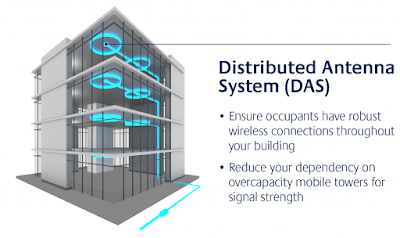This article explores the key challenges of implementing DAS and the opportunities it presents for network operators, businesses, and consumers.
What is DAS?
A Distributed Antenna System (DAS) is a network of spatially separated antennas connected to a central source. These antennas are strategically distributed to enhance cellular coverage and capacity where traditional networks may struggle, such as:
- Stadiums
- Airports
- Skyscrapers
- Tunnels
- College campuses
By extending coverage, DAS ensures seamless communication in areas prone to weak signals or high congestion.
Challenges of Implementing DAS
While DAS offers significant benefits, several challenges can complicate deployment:
1. High Installation Costs
- Expense: Deploying DAS involves substantial investment in equipment, labor, and engineering.
- Cost Distribution: Organizations often struggle to justify costs unless they serve high-traffic areas.
2. Complex Integration
- Infrastructure Coordination: Integrating DAS with existing cellular networks requires careful planning to avoid interference.
- Technology Compatibility: Ensuring DAS works with multiple carriers and technologies, such as 4G LTE and 5G, can be technically demanding.
3. Regulatory Compliance
- Permitting: Acquiring permits and adhering to local regulations can delay deployments.
- Safety Standards: DAS systems must meet rigorous safety standards, especially in public venues.
4. Scalability Issues
- Capacity Needs: As data demand grows, DAS installations must scale to support more users and higher speeds.
- Future-Proofing: Upgrading existing DAS for 5G and beyond adds complexity.
Opportunities with DAS
Despite the challenges, DAS presents numerous opportunities for improving connectivity and user experiences:
1. Enhanced Connectivity in High-Demand Areas
- Seamless Communication: DAS ensures uninterrupted service in crowded venues like stadiums or concert halls.
- Capacity Management: Offloads traffic from traditional towers to prevent network congestion.
2. Support for 5G Deployment
- Critical for 5G: DAS provides the infrastructure needed for dense, high-speed 5G networks.
- Private Networks: Organizations can use DAS to create dedicated 5G networks for secure, high-speed communication.
3. Improved Emergency Response
- Reliable Coverage: DAS enhances communication for emergency services in critical areas like tunnels and airports.
- Public Safety: Supports first responder networks, ensuring rapid and reliable communication during crises.
4. Revenue Opportunities for Operators
- Carrier Collaboration: DAS systems often support multiple carriers, creating revenue-sharing opportunities.
- Business Expansion: DAS enables mobile operators to enter challenging markets, like remote regions or dense urban centers.
Conclusion
Distributed Antenna Systems are essential for meeting the growing demand for reliable mobile connectivity in challenging environments. While the initial investment and complexity of implementation pose hurdles, the opportunities for enhancing coverage, supporting 5G, and improving user experiences make DAS a worthwhile endeavor.
As technology advances and the demand for seamless connectivity intensifies, DAS will play a pivotal role in shaping the future of wireless communication.




